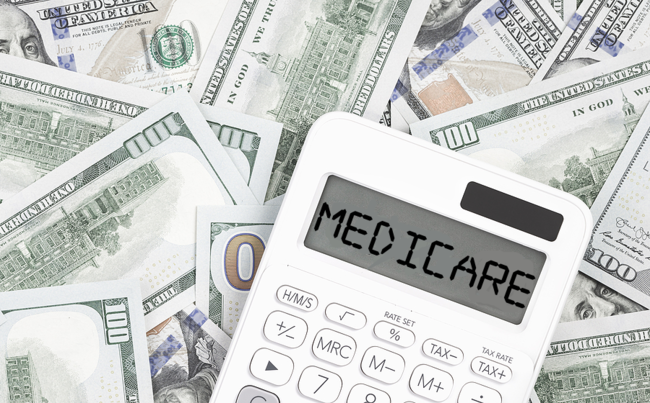Medicare isn’t free.
According to MarketWatch, a study published in the Retirement Management Journal found that retirees between the ages of 65 and 94 spend an average of $4,500 on healthcare costs each year, while a Fidelity study found that a 65-year-old couple will spend of average of $11,400 on healthcare costs during their first year of retirement.
Even with Medicare, healthcare can be expensive. Here’s how much Medicare enrollees can expect to pay – and how they can save.
Medicare Premiums
The premium is the cost to purchase coverage. It is usually paid monthly. Medicare premium costs can get a little complicated. This is because there’s not just one Medicare premium. The different parts and plan types have different premiums.
Most people don’t pay a premium for Medicare Part A. As long as either you or your spouse worked and paid Medicare taxes for at least 40 quarters – that’s ten years – you should qualify for premium-free Medicare Part A. If you don’t qualify for premium-free Medicare Part A, you can buy coverage. In 2021, the cost is $259 a month if you’ve paid Medicare taxes for 30 to 39 quarters and $471 a month if you’ve paid Medicare taxes for less than 30 months.
That’s for Medicare Part A, which covers hospital costs. Medicare Part B covers medical costs, including doctor’s visits and routine care, and it’s not free. In 2021, the standard premium is $148.50 a month. If you earn more than $88,000 a year, or $176,00 if you’re married filing jointly, you’ll be hit with surcharges that will raise your costs. People in the highest income bracket pay $504.90 a month in 2021.
There’s also a premium for Medicare Part D, which is the part of Medicare that provides prescription drug coverage. These are private plans, and the premiums vary from plan to plan. In 2021, the average premium cost is $30.50.
If you enroll in Medicare Advantage, you may have to pay an additional premium on top of your Medicare Part B premium. Some plans have a $0 premium, but you will still have to pay the Medicare Part B premium. In 2021, the average premium for Medicare Advantage was $21. Many Medicare Advantage plans include prescription drug coverage, so you do not need to buy a separate Medicare Part D plan.
Another option is to buy a Medicare Supplement Insurance plan, also called Medigap. These plans are designed to control the out-of-pocket costs in Original Medicare – Medicare Supplement plans do NOT work with Medicare Advantage. According to CMS, the premium costs can vary widely, with different carriers charging different premiums for the same coverage.
Medicare Deductibles, Copays and Coinsurance
As a Medicare enrollee, you will also be responsible for other out-of-pocket costs when you receive care.
The deductible is the amount you have to pay before your benefits kick in. In 2021, the Medicare Part A deductible is $1,484 and the Medicare Part B deductible is $203. Medicare Part D and Medicare Advantage plans can also have a deductible.
The copay or coinsurance is how much you pay each time you receive care. In Medicare Part B, the coinsurance is typically 20% of the Medicare-Approved Amount. If you are hospitalized, you’ll pay the Medicare Part A coinsurance after 60 days per benefit period. For days 61 to 90, the coinsurance is $371 per day. It then increases to $742 per day, until you use all 90 covered days plus your lifetime reserve of 60 days. After that, you pay 100% of costs. Medicare Part D and Medicare Advantage plans can also have copays.
Medicare Supplement plans help cover out-of-pocket costs in Medicare Part A and B.
Other Costs for Medicare Enrollees
Medicare covers a lot of important care, but it doesn’t cover everything. For example, it doesn’t typically cover long-term care costs or care that’s needed when you’re traveling abroad. Original Medicare also excludes hearing, vision and dental care.
These uncovered items can get expensive, but you do have options. You can purchase a separate insurance policy. You can also look for coverage in other Medicare plans. For example, some Medicare Supplement Insurance plans provide coverage for care in foreign countries, and many Medicare Advantage plans cover additional benefits, including vision, dental and hearing.
How to Save on Medicare
As a Medicare beneficiary, you can take steps to get your costs under control.
- Pay attention to all costs – not just the premium. Calculate your expected out-of-pocket costs under different plans.
- Consider buying a Medicare Supplement or Medicare Advantage plan. Medicare Advantage plans have an annual out-of-pocket maximum, while Medicare Supplement plans cover many out-of-pocket costs.
- Pay attention to networks. If you have a Medicare Advantage plan, you need to pay attention to the network of providers and hospitals. If you go outside the network, your care might not be covered.
- Make sure your prescriptions are covered. If you take insulin, look for a plan that is participating in the Part D Senior Savings Model.
- If you are having trouble affording coverage and care, see if you qualify for a Medicare Savings Program or Extra Help.
- Compare plans carefully. Medicare Supplement Insurance plans are standardized, but the premium costs can vary. Medicare Advantage plans often offer additional benefits not covered under Original Medicare, but these offerings vary widely. It pays to shop around!
If you have questions about the cost of Medicare, contact PTT Financial. We’re here to help!

